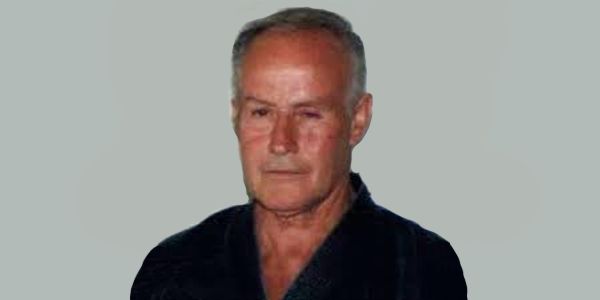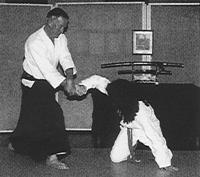Where and when were you born Henry Ellis?
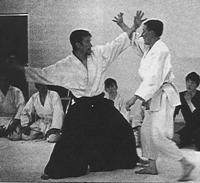 I was born in Yorkshire, in May 1936 in a little coal mining village called Brampton, near Rotherham. A place where you had to fight your way to and from school each day.
I was born in Yorkshire, in May 1936 in a little coal mining village called Brampton, near Rotherham. A place where you had to fight your way to and from school each day.
When did you begin your study of Aikido?
It was in 1957, I was studying Judo and Karate at the Abbe School of Budo at the “Hut” in Hillingdon, Middlesex. My Direct teacher was Mr. Ken Williams, who was 3rd Dan (3rd degree black belt) Judo, and we were all students of Kenshiro Abbe Sensei, 8th Dan Judo, 6th Dan Aikido, 5th Dan Karate and 5th Dan Kendo. At this time no-one in the United Kingdom had heard of Aikido. Abbe Sensei told Mr Ken Williams that we had received a letter from O’Sensei Morihei Ueshiba, stating that all instructors outside of Japan now had permission to teach Aikido to anyone who wished to learn. Mr Williams was his first student and he selected a hardcore of Judo students to study Aikido – this is when I started.
Abbe Sensei made Mr. Williams National Coach for Aikido and I became Mr. Williams assistant, a post which I held for approximately 15 years. Abbe Sensei and Williams Sensei then bought eight of us special students up to 1st Dan, the only Dan grades in Great Britain at that time, and all in one dojo (place or training)! All the Dan grades were hard training and strong with no “bandage men” amongst them. Sunday morning practice was for Dan grades only and Williams Sensei would lock all the doors to the Dojo – it was then the serious practice started, with real fighting. He would allow the younger black belts grades to try to prove themselves against him – with out success, I might add. It was at the time that Sensei started to visit other dojos to introduce Aikido.
I have heard that Aikido training was harder back then…
In the early days the training was extremely difficult, with the emphasis on very strenuous exercise. My students and I used to train four ir five nights a week as well as on Sunday Mornings.
Immediately after talking the students running for several miles, we would return to the mat and perform 200 press-ups on the backs of our wrists, which was then followed by general practice and a further two hours of hard practice. Abbe Sensei’s Aikido was the pre-war style of Aiki Jutsu, which was very physical. Both Abbe and Williams were excellent teachers – they worked very hard to train us, whilst promoting Aikido to a rather unreceptive public.
When I was graded 1st Dan by Abbe Sensei, Williams Sensei instructed me to take a good student as an assistant. The assistant I chose was a 17-year old by the name of Derek Eastman, who is now 3rd Dan and Technical Director or our Basingstoke Headquarters. Mr. Eastman is now 48 years of age and still a loyal friend. It proves one old adage: that you cannot buy or demand respect, you earn it.
At what point did you go “on the road” to spread the Aikido gospel?
When Mr. Eastman reached 1st Dan, I was 2nd Dan and Williams Sensei advised us to spread the word of Aikido. We both gave up our jobs and traveled all around the U.K. It was so difficult trying to introduce Aikido, because most people had never heard of it. Mr. Eastman and I left home and headed for the Midlands, without money and with little hope. In some areas where Sensei Williams had already introduced Aikido, we would find accommodation with the students and receive a small fee for teaching. We would visit Judo and Karate clubs, sports centers, etc. In the areas where there was no Aikido at all, we would take a job for a few days to feed ourselves. We had many jobs and in one area we worked as assistants to a funeral director. We had to collect the bodies from the mortuary and take them back to the chapel of rest. The boss caught me in the chapel of rest with a young maiden who had no right being there….she being very much alive and well. He was very angry with me, and after many escapades he assured me I was on borrowed time. We got a job as road sweepers, wearing bowler hats, which attracted a great deal of attention from the girls. In the North of England the girls loved to hear a London accent, and this was a great help with invitations for dinner and, if we were lucky, accommodation. It was a struggle to survive.
We also worked in steel factories and carried out many other jobs around the country, but without the worst of all was repairing an old railway line. We called it the “railway of death”, the hard work and the foreman were like in the films we had seen on the subject – needless to say, we didn’t stay there for very long. I must add, as look as I look back on my life in Aikido, that this was a really great time. As with all the memories, we tend to forget the bad times and remember the good ones. We contributed greatly to the promotion of Aikido and I do not regret one day of it.
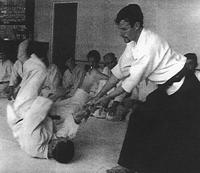 I believe that you trained under Nakazono Sensei in those early days.
I believe that you trained under Nakazono Sensei in those early days.
Yes, that’s right. As I said, Abbe Sensei’s Aikido was all we knew, and when he told us that he had invited a new teacher from Japan to vist us, we were quite excited as we had not seen another Japanese Aikido master. The new teacher was Masahiro Nakazono Sensei and he taught us for 2 weeks. It was 2 weeks of Hell! He had us practicing on the mat for three hours in the afternoon, and the Dan grades had to practice an additional three hours in the evening. During the seminar there were many broken bones and other injuries.
Our etiquette and discipline could not be questioned, and Abbe Sensei had always taught us to use very strong technique in our Aikido and not to be thrown, unless the technique was effective. He also taught us that to be strong showed respect for your teacher. It is important to understand that in these early days that we knew no different, we only knew the strong fighting Art of Aikido. Nakazono Sensei was very angry and perplexed with us. He did not understand us and thought we were being disrespectful to him. It was not until near the end of the seminar that Abbe Sensei explained to him the reason for our approach to Aikido, and then Nakazono Sensei realized we were genuine students with great respect for him and a strong desire to learn.
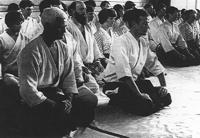 In England it is traditional, after a hard practice, to finish the evening with a pint of beer at the local pub. But Nakazono was keeping us on the mat until 10.00pm., and the pubs closed at 10:30. We were not able change and reach the nearest pub before closing time, so Sensei Williams said to me: “Ellis, as my assistant, it’s your duty to ask Sensei if we can leave the mat at 9.00p.m. so we all have time to get to the pub”. What a fool I was! I did ask Nakazono Sensei and he was very angry with me and said he traveled across the world to teach us Aikido, and all we wanted to do was go to the pub! Well, when he put it like that , it did make us feel bad. However, he didn’t seem to understand that this was our vacation from work . . . I reminded Nakazono Sensei of this incident when we mat in Santa-Fe recently, and we were able to laugh about it.
In England it is traditional, after a hard practice, to finish the evening with a pint of beer at the local pub. But Nakazono was keeping us on the mat until 10.00pm., and the pubs closed at 10:30. We were not able change and reach the nearest pub before closing time, so Sensei Williams said to me: “Ellis, as my assistant, it’s your duty to ask Sensei if we can leave the mat at 9.00p.m. so we all have time to get to the pub”. What a fool I was! I did ask Nakazono Sensei and he was very angry with me and said he traveled across the world to teach us Aikido, and all we wanted to do was go to the pub! Well, when he put it like that , it did make us feel bad. However, he didn’t seem to understand that this was our vacation from work . . . I reminded Nakazono Sensei of this incident when we mat in Santa-Fe recently, and we were able to laugh about it.
The important thing I have not mentioned so far is the vast difference in technique between Abbe sensei’s old style and Nakazono Sensei’s new style, which was a far flowing movement – it seemed so much softer and yet so strong. We quickly adapted to this new style, and it was then that Abbe dropped a “bombshell”. We all would all have to be regarded to meet with the present standards of the Aikikai Hombu (Headquarters) in Tokyo. The grading was physically and mentally demanding, and at the end of it he lined-up all eight Dan grades and said he accepted all out grades with the exception of one. He looked at this student for what seem like an eternity, then said: “Necessary sell your gi (uniform) while price is high”. Even after 37 years that sentence has not been forgotten. He took away that student’s grade.
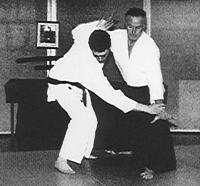
In 1963 I was Nakazono Sensei’s assistant at a national Martial Arts demonstration at the Royal Albert Hall in London – that was a very proud moment for me as a young back belt, and also a proud moment for my parents, as this was the first time they had ever seen me in a Aikido demonstration.
Abbe Sensei then bought over from Paris a young 5th Dan, Masamichi Noro Sensi. This was the first time we had seen a sensei (teacher) in a white hakama (traditional uniform), and Noro turned out to be perhaps the most graceful of all the teachers I have seen to date. There then followed many other fine teachers, like Hiroshi Tada Sensei, Tadashi Abe Sensei and Nobuyoshi Tamura Sensei.
For me the most effective of all the Japanese masters was, without doubt, Kazuo Chiba Sensei. I was with him for several years and once partnered him on television. At that time Chiba Sensei and I were teaching Aikido at out dojo, which was situated at The Times news paper in London, and we were asked to take part in a 30-minute World Service broadcast on the BBC World Radio. Sensei asked me to do the talking, because at the time his English was so good. A television producer heard the broadcast and asked if we would do a demonstration on Anglia TV, to which we agreed. Whilst we were waiting for our ‘slot’, they took us to the hospitality room, where the bar was stocked with just about every drink you could imagine. The hostess asked if we would like a drink, and I thought a whisky would go down well. I asked “Sensei, can we have a drink?”. He said we could, but before I could order, Sensei had asked for two orange juices.
Some Aikido I have seen in recent years depresses me because it can be carried out by two Aikidoka who practice together on a regular basis, like a couple of dancers who know each others movements. I honestly think that a majority of students take up Aikido for self-defense, so if I wanted Yoga I would study Yoga, and if I wanted to dance I would take dancing lessons. I believe Aikido no only has to look good, but also has to be effective.
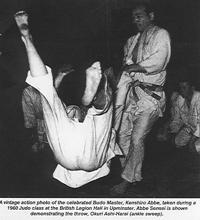 Abbe Sensei not only taught Tori (performer of technique) to have good posture and balance, but Uke (receiver of technique) had to attack on balance also, since it is easy to throw when he comes off balance. He used to teach with a shinai (bamboo sword), with which he would hit and say: “My English is not very good, but my shinai speaks fluent English”. You can tell a student 20 times what he isdoing wrong before he gets right, but the shinai speaks only once, with incredible results. I still occasionally teach the high grades with a shinai. In the early 1960s I was asked to carry out a Aikido demonstration at the British Judo Council’s National Championships in London. It was to be the most important demonstration to date. The VIPs were the Japanese Ambassador and Lady Baden-Powell, wife of Lord Baden-Powell, who was then the head of the World Organization of Boy Scouts. Kenshiro Abbe Sensei and Masutaro Otani Sensei, 8th Dan, another Japanese master, emphasized how important this evening was, and wanted an impressive display from the Aikido people. Whilst we were waiting to go on, a Judo Dan grade approached Otani, who was speaking to the Japanese Ambassador, and said: “Hey, Smiler”. I couldn’t believe the disrespect and took him to one side. We were in a confrontational situation when Derek Eastman, who had been outside smoking a cigarette, called me to inform me that we were due on stage immediately. We rushed onto the stage and as I performed the technique. Mr. Eastman’s cigarettes and matches fell from his go, onto the stage. I was already upset from the previous incident, and now this embarrassment was the final straw. I smashed Mr. Eastman all over the tatmi (mat) and back again. When demonstrating knife defense, the knife went thought my gi and I felt the blade against my stomach and thought: “My God, it’s in me!”. I dropped to my knees with Mr. Eastman in immobilization as I withdrew the knife from the hold in my gi. I expected blood to flow but . . . nothing! It turned out to be just a graze. I looked in the front row, and staring at me with shock and horror was Her Ladyship, and I knew by her face that any hopes we had of entertained of securing her sponsorship for Aikido had disappeared. In fact, Her Ladyship was quoted as saying: “That was the most horrific display of violence I have ever witnessed”. The Japanese Ambassador, on the other hand, congratulated us on a excellent display.
Abbe Sensei not only taught Tori (performer of technique) to have good posture and balance, but Uke (receiver of technique) had to attack on balance also, since it is easy to throw when he comes off balance. He used to teach with a shinai (bamboo sword), with which he would hit and say: “My English is not very good, but my shinai speaks fluent English”. You can tell a student 20 times what he isdoing wrong before he gets right, but the shinai speaks only once, with incredible results. I still occasionally teach the high grades with a shinai. In the early 1960s I was asked to carry out a Aikido demonstration at the British Judo Council’s National Championships in London. It was to be the most important demonstration to date. The VIPs were the Japanese Ambassador and Lady Baden-Powell, wife of Lord Baden-Powell, who was then the head of the World Organization of Boy Scouts. Kenshiro Abbe Sensei and Masutaro Otani Sensei, 8th Dan, another Japanese master, emphasized how important this evening was, and wanted an impressive display from the Aikido people. Whilst we were waiting to go on, a Judo Dan grade approached Otani, who was speaking to the Japanese Ambassador, and said: “Hey, Smiler”. I couldn’t believe the disrespect and took him to one side. We were in a confrontational situation when Derek Eastman, who had been outside smoking a cigarette, called me to inform me that we were due on stage immediately. We rushed onto the stage and as I performed the technique. Mr. Eastman’s cigarettes and matches fell from his go, onto the stage. I was already upset from the previous incident, and now this embarrassment was the final straw. I smashed Mr. Eastman all over the tatmi (mat) and back again. When demonstrating knife defense, the knife went thought my gi and I felt the blade against my stomach and thought: “My God, it’s in me!”. I dropped to my knees with Mr. Eastman in immobilization as I withdrew the knife from the hold in my gi. I expected blood to flow but . . . nothing! It turned out to be just a graze. I looked in the front row, and staring at me with shock and horror was Her Ladyship, and I knew by her face that any hopes we had of entertained of securing her sponsorship for Aikido had disappeared. In fact, Her Ladyship was quoted as saying: “That was the most horrific display of violence I have ever witnessed”. The Japanese Ambassador, on the other hand, congratulated us on a excellent display.
In those days, the style we practiced was hard and positive, as well as being defensive. If I had only know some of the thing I was later to acquire from Nakazono Sensei’s teachings, this could of given Aikido a major boost in the U.K.
Could you talk about your own philosophy of Aikido and feeling on Budo (the ‘Way’)?
I still practice the old, original Aikido, which appeals to my positive nature and attitude. The early traditional style of Aikido is that of O’Sensei as a young man – a fighting man. My own understanding of O’Sensei’s life of Aikido was that he developed Aikido as a fighting art as well as a positive form of self-defense. His life changed as he became older and so did his Aikido – he became more involved in the philosophy of his art. I have heard and read of other sensei who were close to him, who said they could maybe only understand 10%of what O’Sensei taught. If that is true, then what chance have we of understanding the depths of his mind?
I have met many Western sensei who have delved so deep they almost think there Japanese. I always tell my students that we are practicing a Japanese Martial Art, but remember, we are Westerners, and therefore we must reach a happy compromise between East and West. I teach some Japanese words, but I don’t go “over the top”. When I was teaching in America, I was asked to visit a large dojo in Texas. Everything they said was in Japanese, so I tried to look as if I understood, but to be honest I didn’t have a clue, and I don’t suppose a Japanese person would understand much of our Western interpretation of their language either. I am often asked what are the best books or videos to buy, and I always point to the tatami and say: “That’s where it’s at!”.
In the beginning, Abbe Sensei would not discuss ki (spirit, mind, energy) – he said you had to be 1st Dan before you could understand. I still agree with that. What I find a little disturbing in Aikido is that some people really believe that ki is almost a form of magic. Abbe Sensei’s method was that you first trained very hard physically to develop your spirit and mind. He said that when the body says it say its tired the strong mind will over-ride it and carry on.
Some teachers of Ki Aikido have had previous study of traditional Aikido, and this, along with the practice of ki, is good. But the students who have been taught only ki style cannot fall back onto good, solid, traditional style when in difficulty with certain techniques. My own students are aware of ki and it meaning, but it is not a word use very often. I teach students the flow and power of breathing as an important part of there exercise and Aikido training.
During Nakazono Sensei’s last visit to the U.K., he asked me to be his assistant at a demonstration at a venue in Acton, London, for Otani Sensei. Chiba Sensei was there too, but only as a spectator. Knowing how hard Nakazono was from the past experience, I feared the worst and thought I was in for a hard time, but Sensei was a little older and had changed dramatically. I think he threw me only twice, and then we spent about an hour kneeling while
Sensei went into some very deep philosophy which none of us could understand. Even Chiba
Sensei looked puzzled, and when I think of this particular seminar, I wonder: Is this how O’Sensei changed?
When I saw Nakazono Sensei again in Santa Fe, New Mexico, he gave me two books he had written and signed them for me. I spent about four hours at his home, and he and his wife made me feel most welcome, which made me think: Yes I am a privileged student.
After about 40 years in the Martial Arts, with many friends who are bouncers, boxers, fellow Martial Artists and street fighters, it is my honest opinion that the hardest man to beat is the natural street fighter. My assistant for many years and a great personal favorite of Chiba Sensei, was “Mad” Geoff Goodwin, who disappeared some years ago. Geoff came from Derbyshire and followed me to London, where he later became my special assistant. He was a natural born street fighter and we had some great battles.
My son, Richard, who studied Aikido from the age of 5 and continued to the age of 14 years old, is also a natural street fighter. He has now been back into Aikido for a year and is running the junior section with great success. We often practice together and I try my techniques against him, and with his natural balance and Aikido training, his reactions and responses are very fast. It makes you very aware than an opponent has more than one hand.
I teach as Abbe Sensei did, that Uke must attack on balance, remember at all times that two people are practicing, Tori to throw, and Uki Atemi and Ukemi. What I don’t allow is the Uke attacking with his or her back leg off the mat. I also don’t like to see Uke trotting around Tori’s circle on his toes like a trained poodle on a lead, waiting for the instruction to jump!
You have dojos in the United States affiliated to your school, I believe.
Yes, in Dallas, Texas and in Alamogordo, New Mexico. The teachers there, Al Montemar and David Rogers, were my students in the early 1980s when they were with the U.S. Air Force at Greenham Common. I was fortunate enough to be able to visit both dojos during 1992 and give seminars and grading examinations for my American students.
I know that Abbe Sensei told you how he first came to Aikido – would you mind recounting that particular story?
I’d be happy to. Abbe Sensei was All Japan Judo Champion at the age of 18, prior to World War II. He told me that he was rather arrogant at that time, having achieved fame so young. Anyway, it was during a train journey in Japan that he first met O’Sensei. Abbe didn’t know who he was and he reacted to Ueshiba Sensei looking at him, saying: “What are you staring at, old man?” Ueshiba replied: “I know who you are”, to which Abbe modestly retored: “Everyone knows me, I am Kenshiro Abbe, Champion of All Japan”. O’Sensei then introduced himself as the Founder of Aikido, and was told by Abbe that he didn’t look strong enough to be a Martial Arts Master. O’Sensei then offered Abbe his little finger, and said: “But young man, you look very strong indeed. Please break my finger”. Abbe at first declined, but eventually accepted the challenge, presumably to shut the old man up. Abbe Sensei told me that, as he took hold of the old man’s finger and tried to break it, he found himself on the floor of the carriage and totally immobilized. Whilst on the floor Abbe asked the Founder for permission to study under him. This is my understanding of Abbe Sensei’s story.
When you were in my ‘local’ earlier, you told me a couple of interesting stories about one of your former teachers. Could you repeat them for this interview, please?
Certainly, but I think its better that we don’t print the man’s name. Well he was a 2nd Dan in Aikido, under Ken Williams, and also held equivalent ranks in Judo and Karate. He was a strange character and used to speak in affected, Japanese broken English, and one day he said to me: “Mr. Ellis want to come my house for supper?” So I said: “Yes Sensei, I’ll come for supper, thank you”. I went along to his home, knocked on the door and it was opened by this guy wearing a black silk Kimono (traditional Japanese gown) and Geta (clogs). I was a little taken aback by all this, but went in and we sat down.
After a couple of minutes, Sensei clapped his hand and his wife came trotting in from the kitchen, also in a Kimono. So, the first thing he did was slap her across the face three times. Her head rocked back and forth but she didn’t say a word, or even cry. I just looked on in total amazement . . . it was unbelievable. He told her to prepare the meal, and she returned to the kitchen. When his wife had left us I told him that I thought he was out of order. This chap replied that Abbe Sensei had told him that it was a Japanese tradition to slap one’s wife every morning to teach her humility! I pointed out to him that he was not Japanese but to no avail, as he slapped her again when he ordered our drinks! I was never the same with him after that…it was incredible behavior.
You did, in fact, come to blows with this particular man later on, didn’t you?
Yes, I did, Arthur. We were in this pub after training and he said to me: “You think you can take me, don’t you?” I told him that I’d never thought about it, to which he replied: “Oh yes you have you think about it all the time”. Again I denied this, it was just bloody rubbish, but he would not let go. He kept baiting me, saying: “You want to try?” and I said to him: “You know Sensei, the only person troubled by this is you. It is you who are unsure about me, not I about you”. So he said: “Let’s go outside”, and out we went. Outside the pub he put himself in a Aikido posture, so I just stood there as relaxed as possible, and waited. As soon as he came for me, I hit him and put him on the deck. As he went down I dropped and immobilized him with my knee on his neck. At this point he said: “OK, that’s enough, let me up” I said: “Is that it? Is this incident finished?” He replied that it was. Well, I’m a very straight man, and if someone say its finished, then for me its finished. So as soon as I let him go, he smacked me straight in the nose and broke it, I was covered in blood and in abit of a mess. He lost not only my respect, but everyone who had been present. He moved form the area soon after that, and I’ve never seen or heard of him since.
Finally, Henry, do you have any advice that you would like to offer to Aikido practitioners?
I would urge them to visit other clubs and look at other methods. You don’t have to like everyone’s Aikido, but if you can take away a little for each dojo you visit, it will make your own Aikido complete. Also I would like to say stay clear or ‘fairy’ Aikido remember , it’s a Martial Art and must work.
Henry, thank you for your time and patience.
My pleasure, and thanks to Pat and you for your hospitality.
By Authur Lockyear Fighting Arts Magazine


